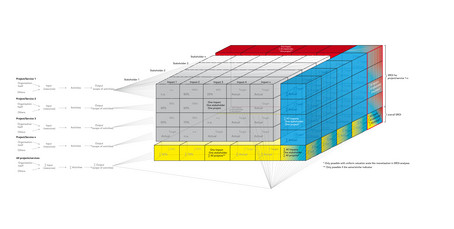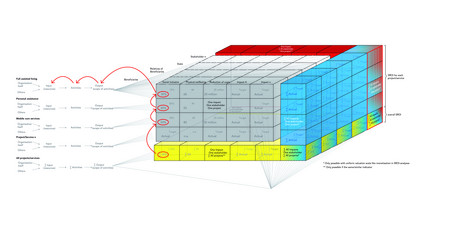Impact-oriented controlling box
Consistent impact orientation of organisations or the public sector requires impact-oriented controlling. The impact-oriented controlling box is a tool that builds on an overall organisational impact model of an organisation or a sector and considers the impacts of different services on several stakeholders at the same time.
The first step is to define indicators for measuring impacts for different stakeholders and to set target values for those indicators . It is usually necessary to prioritize impacts, as not all impacts can be measured due to limited resources. The target values can be found in the grey fields of the controlling box (see figure below). In a second step, the intended impacts are hypothetically linked to projects/services provided and impact value chains are built for each service and stakeholder. How do services or products effect different stakeholders? This is the impact model of an organisation. The first two steps, the definition of goals and the elaboration of how these impact goals are achieved, define the strategy of an organisation.
The transition from strategy to management is the next step. It is characterised by the orientation towards verifying impacts. The aim is to show empirically the actual status of achieving one’s impact by gathering data (also grey fields in the figure). In this step, it is important to choose an approach to identify or measure impacts that suits the organisation and its activities. In this process, impacts can also be identified that were not intended and later are not significant at first in a variance analysis (comparison of target and actual status). However, in the sense of an iterative process, these can flow into the (future) strategy development. In a fourth step, actual values are compared with the target values set at the beginning by means of a variance analysis. It becomes clear what services achieve a target value established for them to what extent. Hereby, possibilities to adapt existing services could be identified in order to better achieve impact goals (target values) in the future.

The impact-oriented controlling box explained by Christian Grünhaus & Constanze Beeck

Impact-oriented controlling box
Aggregation of impacts
In concrete terms, the impact-oriented controlling box is an instrument that is created and filled with data for projects or services, stakeholder groups and intended impacts and corresponding indicators. Usually, the instrument is applied in the form of a database or at least an Excel-based pivot table.
The concept of the impact-oriented controlling box enables a differentiated view of projects or services and the intended impacts generated. At the same time, it offers an overall view of the impact of the projects or services in individual impact dimensions, on individual stakeholders or aggregated on society as a whole. In this way, on the one hand, aggregated controlling can be carried out and, on the other hand, data is available to present the impacts across all services and stakeholders. This also facilitates communication and legitimisation of the organisation.
Example of an impact-oriented controlling box
Of course, when interventions are taken to change a (desired) impact, attention must be paid to the extent to which other impacts are affected. A reduction of service A and an expansion of service B to increase impact A can, under certain circumstances, reinforce another undesired impact. Here, in a participatory, political negotiation process or on the basis of the mission statement or the fundamental laws and legal framework conditions it must be weighed up which concrete change should be made. By using the impact oriented controlling box decisions are not based on data and indicators on input and output, but on data and indicators on impact.

